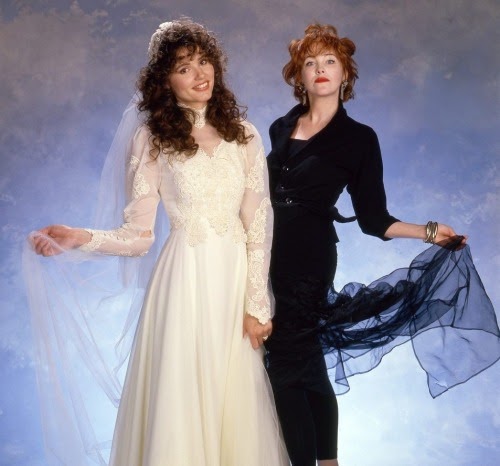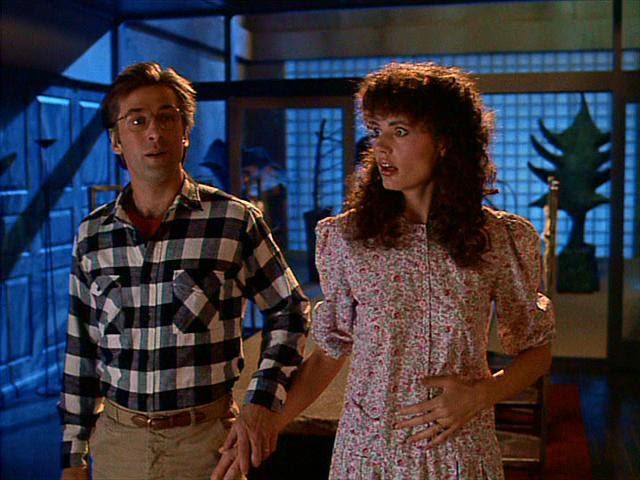
My worn-out copy of Beetlejuice (taped off the telly alongside Labyrinth) was a familiar childhood companion, often brought out at family sleepovers to keep me from screaming the house down. Oddly enough, I now find the film strangely comforting despite its bleak subject matter; perhaps the older I get, the more I recognise my own mortality and those around me. In a funny sort of way, at the age of 32 (the film and I share a birth year), a 600-year-old rotting, green-haired creep helps me confront death.
Now may be the perfect time to reacquaint yourself with Beetlejuice, Tim Burton’s offbeat comedy about the afterlife, isolation and strained relationships. Sound familiar?

Thankfully we should be back to normality by the end of the year which seems a little easier to digest than the 125 years confinement the Maitlands face in the film. Within the first ten minutes of the film, Adam Maitland (Alec Baldwin) and Barbara Maitland (Geena Davis) tragically drown in a freak accident leaving them stuck in an afterlife limbo within their former home. Just as the couple get to grips with their ‘new normal’, the Deetz’ arrive. Unable to live alongside the nouveau riche family, the Maitland’s summon Betelgeuse (Michael Keaton), a self-proclaimed “freelance bio-exorcist” who claims to be able to get rid of the living.
Aggie Guerard Rodgers’ offbeat costumes play a major part in Beetlejuice’s storytelling and quickly introduce the audience to the film’s players. Take for example the waiting room where several recently deceased characters are stuck, waiting in a paper-pushing purgatory. There is a blend of character makeups and ‘plain’ clothed actors amongst the crowd, all dressed to reflect who they were at the minute they passed. Characters range from the fantastic (green-hued creatures and shrunken head explorers) to the mundane (a run-over postal worker). Although Betelgeuse’s rotting black and white stripe suit has rightfully cemented its place within cinematic history, it is the costumes of Barbara Maitland and Delia Deetz (the exquisite Catherine O’Hara) that get better with every watch.
Barbara Maitland is a dutiful housewife dressed primly in Laura Ashley. She wears an awkward pink prairie dress with a drop waist, button-down back, matching pink house-apron and pastel ballet flats for the majority of the film. Davis’ naturally tall stature makes Barbara appear cumbersome at times, the dress and flat shoes arguably unflattering. Her husband Adam wears a black and white plaid flannel shirt, red t-shirt and beige chinos. Husband and wife complement each other with their traditional outfits.

The Maitlands life story is imprinted into their clothing, their banal outfits quickly portraying their ‘normalness’ in comparison to the wildly dressed Deetz’. Rogers uses a traditional feminine warm pastel palette to dress Barbara, evoking fresh linen and warm apple pies. On the other hand, Delia, the film’s other matriarchal character, wears a stark palette of black, white and blood red. Lydia shows contempt for her step-mother and feels alienated by her new family set up. However, when Lydia discovers the Maitlands living in the attic, she immediately establishes a connection with the welcoming Barbara despite her un-hip looks.
Barbara and Adam’s eternal house clothes reflect our relationship with clothing. Often when a loved one dies we hold onto their favourite scarf or jacket, feeling a close connection to them for years to come. However uninteresting, clothing means more when it is worn by someone, it can become intrinsically linked to the wearer. The couple’s tangible connection to their former wedding clothes is used by Otho (Glenn Shadix) in an attempt to summon the couple from the afterlife. Death comes to us all and Barbara’s house dress emphasises this— yes, it could really happen when you are slobbing out in your leggings and stained band hoodie. Let that be a warning.
Delia Deetz is a self-indulgent artist trapped in her idea of living hell following her husband’s nervous breakdown— a little town New England where you can’t even get a hip takeaway: “I can’t believe we’re eating Cantonese. Is there no Szechuan up here?” Her eccentric glamour feels perfectly at home in the newly renovated home which the family fill with Delia’s menacing sci-fi plant sculptures. The walls are an odd pebble dash and the once quaint wood panelling and chintz wallpaper have been transformed into a cold, brooding Expressionist scape. The Maitland’s dislike Delia immensely, referring to her as ‘that woman’ and no wonder— Delia is delightfully insufferable.

Her fashion choices are nothing short of iconic. Clothes on Film explained how Rogers had a difficult time convincing Burton to splash out on Delia’s designer wardrobe but thankfully he relented and Delia hams up her New York artist persona by storming into sleepy New England wearing conceptual designs from emerging designers Issey Miyake, Rei Kawakubo of Comme des Garçons and Mitsuhiro Matsuda. Traditional tailoring is off-set with juxtaposing proportions and she often wears her clothes inside out. Most fantastically, Delia re-purposes Charles’ (Jeffrey Jones) homey red sweater and wears the knitwear as trendy low hanging trousers whilst making the infamous shrimp dinner.
Outlandish accessorises including a mini top hat swatched in red tulle and industrial-sized drop earrings finish off Delia’s conceptual looks. Her makeup is equally as loud with a smearing of fuschia and red lipstick, with her copper hair teased and pulled into multiple tiny ponytails. She even fashions a surreal hair wrap with the help of one black leather glove— quite honestly my favourite Delia fashion moment.
She gives her opinion freely of the home’s former style-starved residents and is more shocked by the lack of closet space than when she eventually meets the deceased. Even faced with the realisation there is life after death, Delia still cannot shake off her desire to impress the fashionable art crowd, retorting to Lydia following an argument about the Maitlands, “no one dining this evening hasn’t been in Vanity Fair except you”.

Delia is nothing short of obsessive in her dedication towards her artistic life. Remember “this is my art and it is dangerous”. Mirroring her abstract sculptures, her clothing acts as a walking advertisement for her work. Even in sleep, Delia does not let down her sartorial defences, as she lies swathed in black chiffon and smudged lipstick. Perhaps her overt style also reads as a defence mechanism? Critics berate and negatively critique her work, even her agent who reminds her she will always be a “flake”. Highly strung, neurotic and overly dramatic Delia is desperate to be accepted.
In many ways, Barbara and Delia are complimentary characters however aesthetically different. Deep down Delia is a devoted wife to Charles and shows a (small) amount of concern over her step-daughter Lydia growing up in a house overrun with ghosts. Finally finding success within the art world thanks to her Betelgeuse serpentine sculptures, Delia recoils and Charles finally gets the relaxation he’s been searching for. The Maitlands live out the rest of their 125 years sharing their home with the Deetz’. Barbara’s maternal instincts are fully realised as we learn the couple have been tutoring Lydia in exchange for after school Harry Belafonte possessions. Ever seems to live happily, everyone except Betelgeuse who is sent to live out the rest of eternity in the afterlife’s waiting room.
Beetlejuice is available on Netflix UK and AUS now. It is also available for rental on VOD
by Casci Ritchie
Categories: Anything and Everything

1 reply »